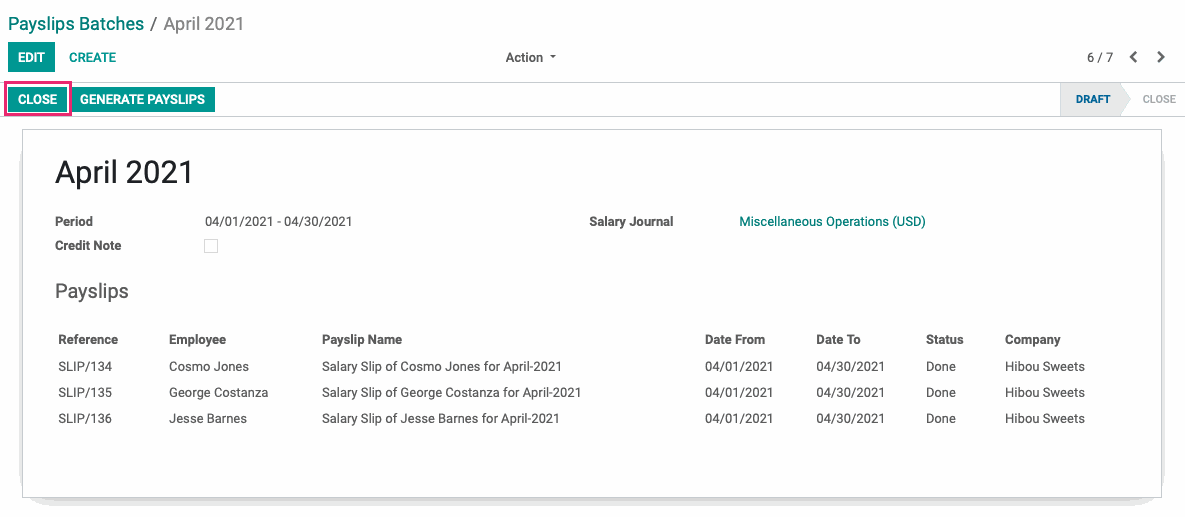Payroll: Payroll Workflows: How to Run Payroll
Purpose
The purpose of this documentation is to outline the use and processes associated with running payroll and creating payslips in the Odoo 12 Payroll application. We will cover creating individual payslips as well as payslip batches.
Before You Start
This document outlines this process with the use of Hibou Payroll Payments. Please take a moment to install this module according to the instructions found at Human Resources (HR): HR Payroll Payment.
Process
Running Payroll for Individual Employees
Next, navigate to the Payroll application.

Once there, click CREATE to open the new payslip form. On this page, you will see the following fields:
Employee: Select the employee.
Period: Select the period.
Reference: You can create a reference manually for this payslip, or you can let Odoo create one when you hit Compute Sheet.
Payslip Name: This will be pre-filled when you enter the employee name, but can be edited.
Has Been Paid: Indicate if you're creating a payslip for a payment that's already been paid.
Contract: This will automatically fill based on the employee's contract configuration. For more information on Employee Contracts, see our Employee Contracts documentation.
Structure: Salary Structure will automatically be filled in based on the employee’s contract configuration. For more information on Employee Contracts, see our Employee Contracts documentation.
Credit Note: Check this box if this payroll slip is a credit of another.

When you're ready, click COMPUTE SHEET. When the computation is complete, click SAVE.
Notice that Odoo has assigned the payslip a unique Reference. Now, let's review the information on the tabs, below.

Under Worked Days & Inputs you will see the types of activity the employee is being paid for and the number of days and hours they worked.
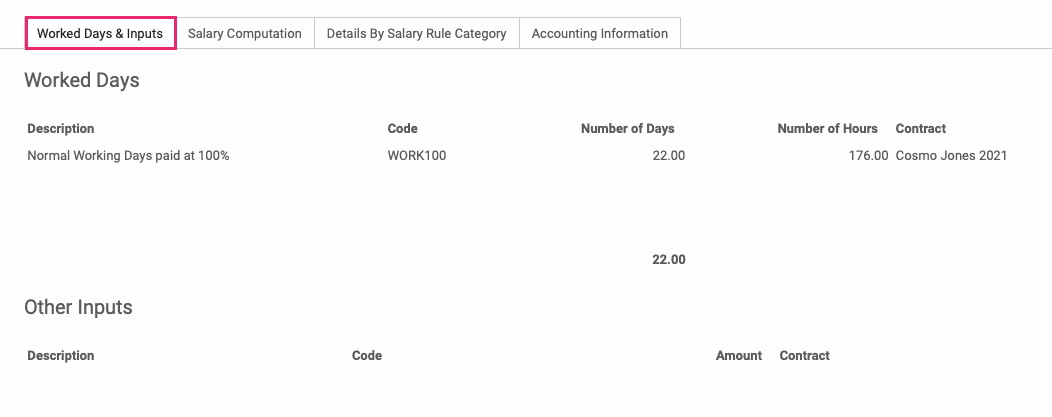
Salary Computation provides a break down of the payslip Salary Rules calculated in sequence order with associated rates.
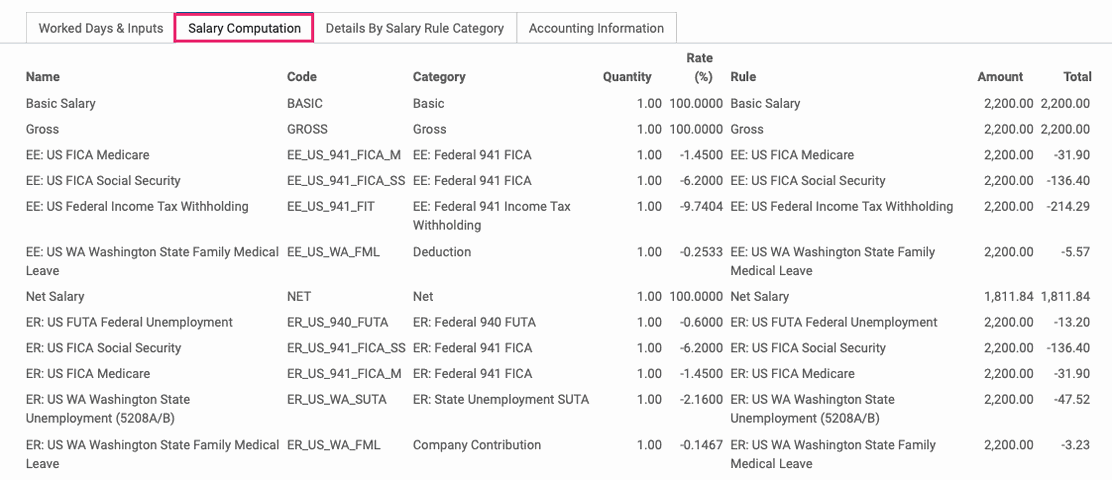
The Details by Salary Rule Category tab shows a break down of the payslip Salary Rules by Category and in Sequence order.

Under Accounting Information, you will find two sections:
Miscellaneous
Payslip Batches: Indicates that this payslip was created or added to a Payslip Batch. Batches are discussed below, on this page.
Accounting
Made Payment Order?: Check this box if this payslip has already been paid.
Date Account: Date that the payslip journal entry will be dated. If not manually edited, this will default to the last day of the pay period once confirmed.
Salary Journal: This is your payroll journal. This should be selected by default based on the employee's contract configuration. For more information on employee contracts, see our Employee Contracts documentation.
Accounting Entry: Journal entry name (begins with your payroll journal's short code) posted to the general ledger in the Accounting application. This will automatically be filled when you create the draft entry.

After reviewing all tabs to make sure the payslip amounts look correct, click confirm. This will generate a draft Accounting Entry reference that you'll see under the Accounting tab. You can select this entry to see the journal items associated with this payslip.

To register payment for this payslip, click Register Payment. This brings up the Register Payment modal window. Here you should verify the details of this payment before proceeding:
Partner: The contact record that represents the employee's private mailing address. This field is populated from the employee template.
Payment Method: The account this employee is being paid from. If you don't see the Payment Type below this field, select a different method, then reselect your preferred method and it should display.
Payment Type: The manner by which the employee is being paid. If you don't see these options, try re-selecting the Payment Method to force the options through.
Payment Amount: The amount being paid to the employee for this payslip. This field is populated from the payslip.
Payment Date: The date the payment is being issued to the employee.
Memo: The payslip name, populated from the payslip.
Payment Transaction: This field can be ignored for payroll as it relates to making a payment on a Sale Order.
When you've verified all information is correct, click Validate. Note that this only records that you've made a payment by the payment type shown. This does not pay your employee on your behalf.
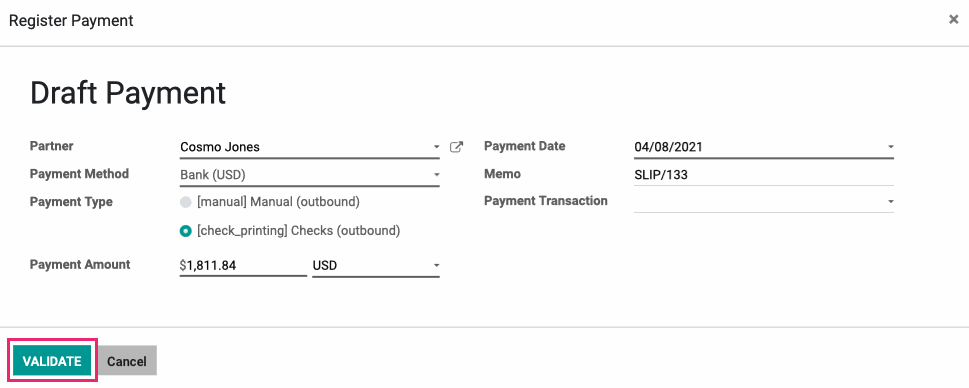
Good to Know!
Payroll Payments Module
If you did not install the Hibou Payroll Payments module, as outlined at the beginning of this document, then you will not see the Register Payment button. Instead, a draft entry will be created in the Salary Journal and you'll need to manually record those payments when completed.
Once you've registered and validated payment, you'll then see the Has been Paid field is checked, indicating the payroll payment is complete.

Important!
If you find that a payslip is missing hours after you've posted it, you'll need to delete that payslip and generate a new, correct version.
How To Create Payslip Batches
In most situations, you will likely wish to generate payslip batches, rather than individual payslips. To get started, navigate to the Payroll application.

Once there, go to Payslip Batches, then click Create. This opens the Payslip Batches form where you'll fill in the following fields:
Name: Create a name for this payslip batch.
Period: Select or enter the payroll period being paid. this will default to the current month.
Credit Note: Leave this unchecked. If this is checked, it indicates that all payslips generated are refund payslips.
Salary Journal: Select the journal this batch will be recorded to.
When that information has been entered, click save. Once saved, Generate Payslips.
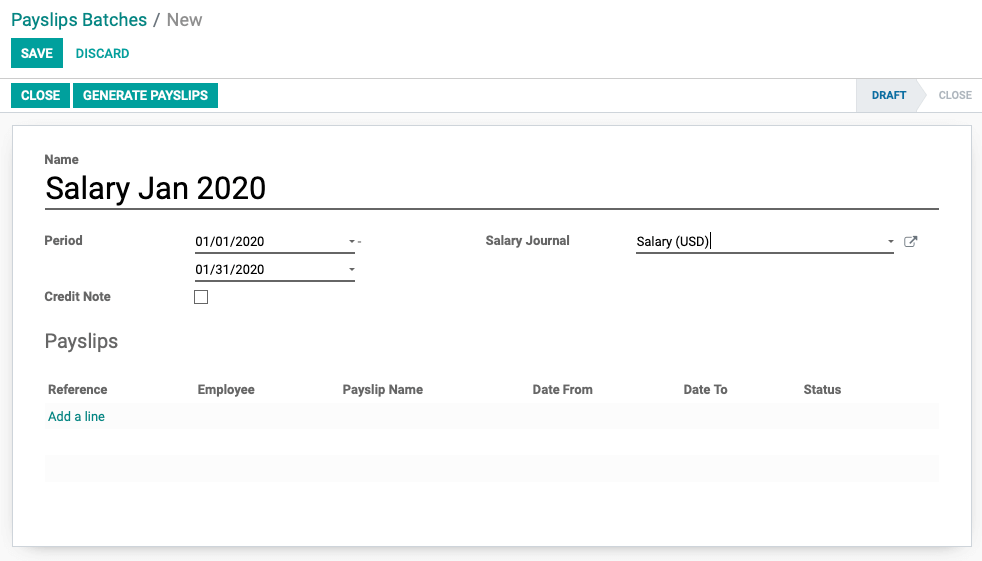
This will bring up the following modal window with a list of employees who qualify for this payment period.
You can click Add a Line to add more employees from your list of employees. You can also remove employees from this list by clicking the icon to the far right. Note: You may need to scroll to the right to see this icon.
When you're ready, click Generate.
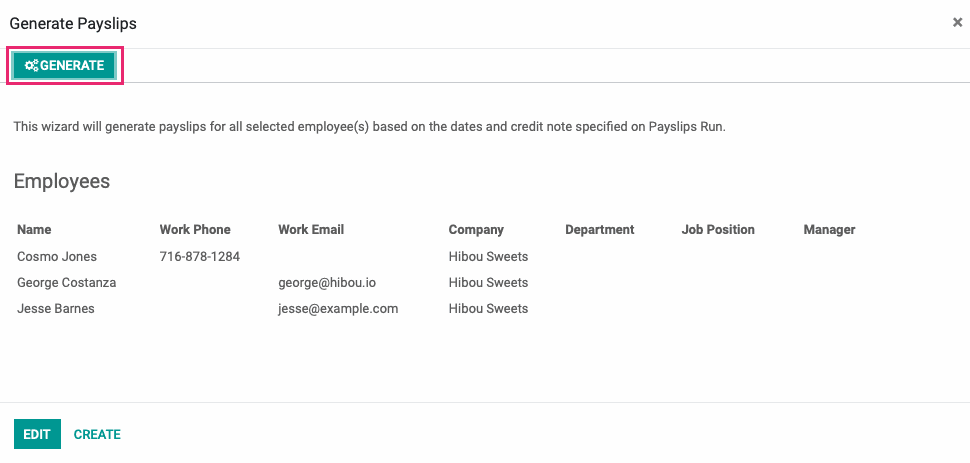
This brings you back to the previous window and you'll see the list of payslips generated under the Payslips heading.
At this point, you have the option to ADD A LINE to create a payslip for another employee or click the bin icon to remove that employee from this batch.
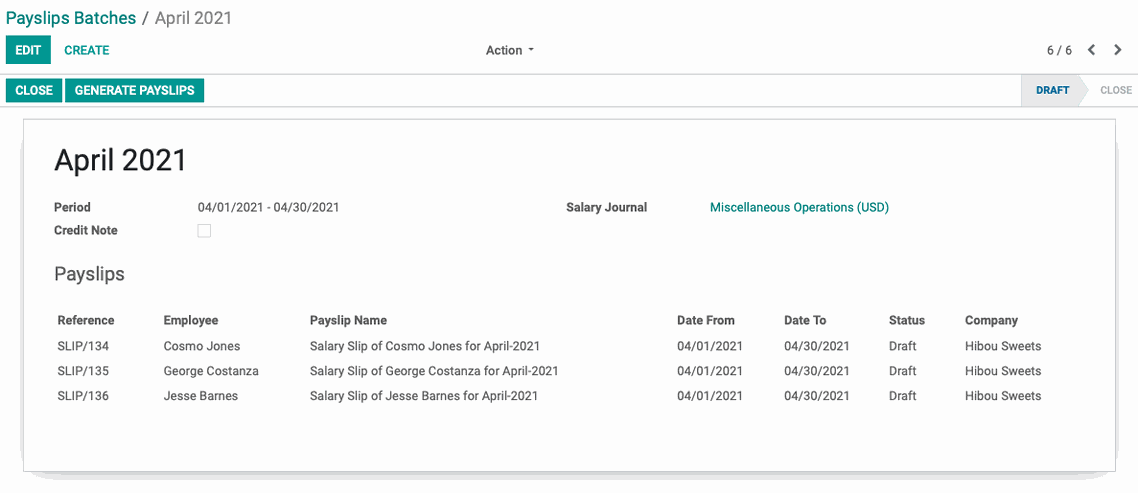
When ready, click Save. The next step is to review each individual payslip before registering payment. We'll cover that in the next section.
Registering Payment After Reviewing Payslips
On the batch record, click EDIT, then, click the first employee in the Payslips list.

This opens the individual payslip record.
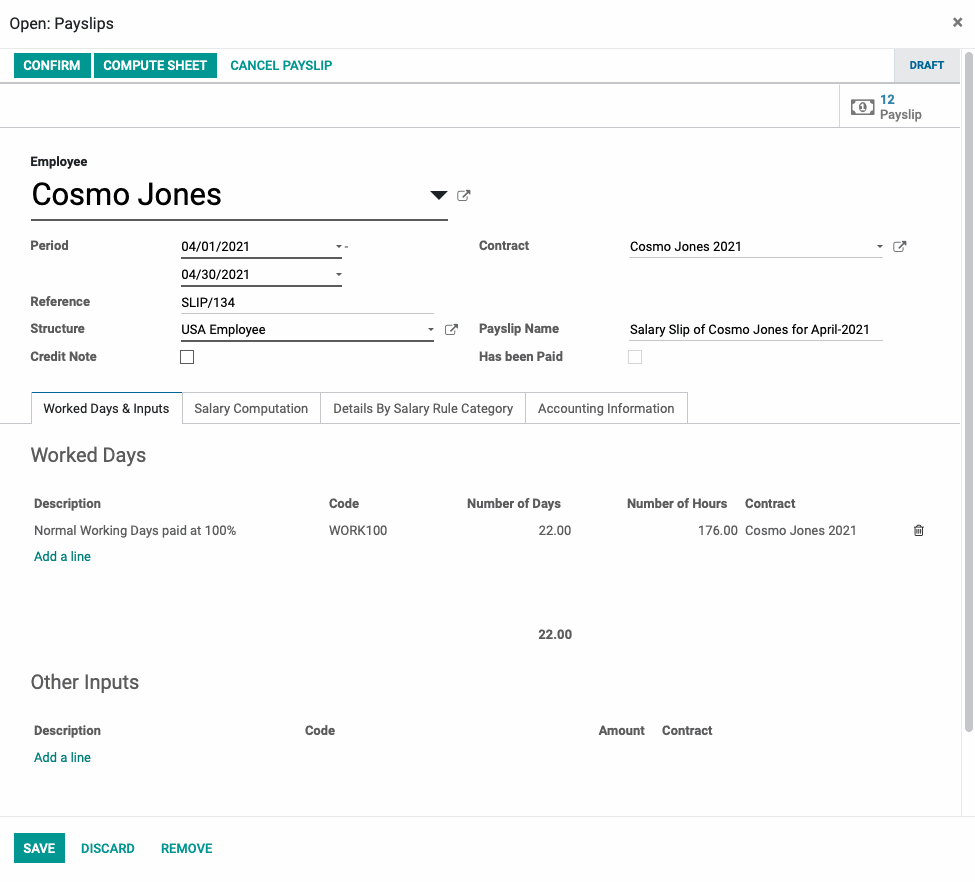
On the slip, you will see several tabs:
Worked Days & Inputs: You will see the number of days and hours worked and on which contract. Sick days and PTO will also appear as lines here, if applicable.
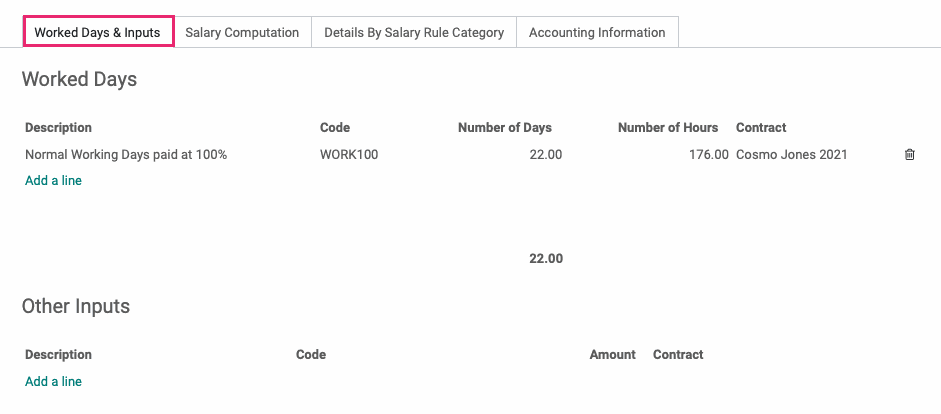
Salary Computation: Here, you will find a breakdown of the payslip Salary Rules calculated in sequence order with associated rates.

The DETAILS BY SALARY RULE CATEGORY tab shows a breakdown of the payslip Salary Rules by Category and in Sequence order.

In Accounting Information you will find the following fields:
Miscellaneous
Company: In a multi-company database, this will set to the company you're working in.
Payslip Batches: The name of the payslip batch will appear here.
Accounting
Made Payment Order?: Check this box if this payslip has already been paid.
Date Account: Date that the payslip journal entry will be dated. If not manually edited, this will default to the last day of the pay period once confirmed.
Salary Journal: Your payroll journal. It should be selected by default based on the Employee’s Contract configuration.
Accounting Entry: Journal entry name (begins with your payroll journals short code) posted to the general ledger in the Accounting application. This will not be filled and the journal entry will not be created until you create the draft entry.

Once you have verified that this information is correct, or made any necessary changes, click Confirm at the top left.
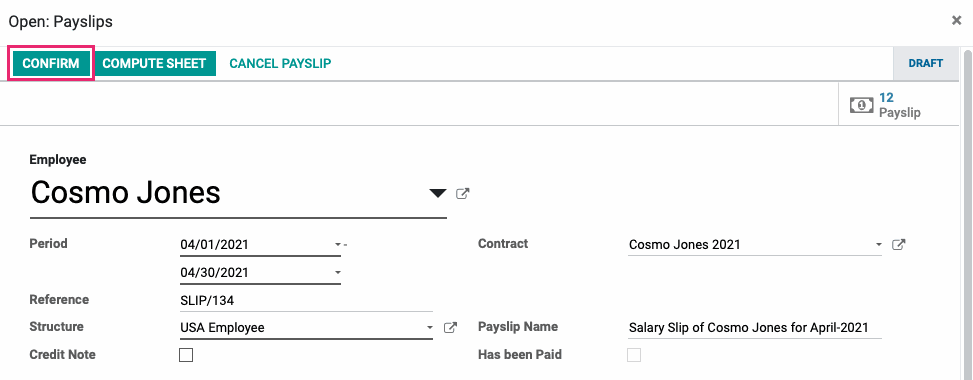
In doing so, you'll see the accounting entry has been made and is reflected on the Accounting Information tab.

To register payment for this payslip, click REGISTER PAYMENT. This brings up the Register Payment modal window.
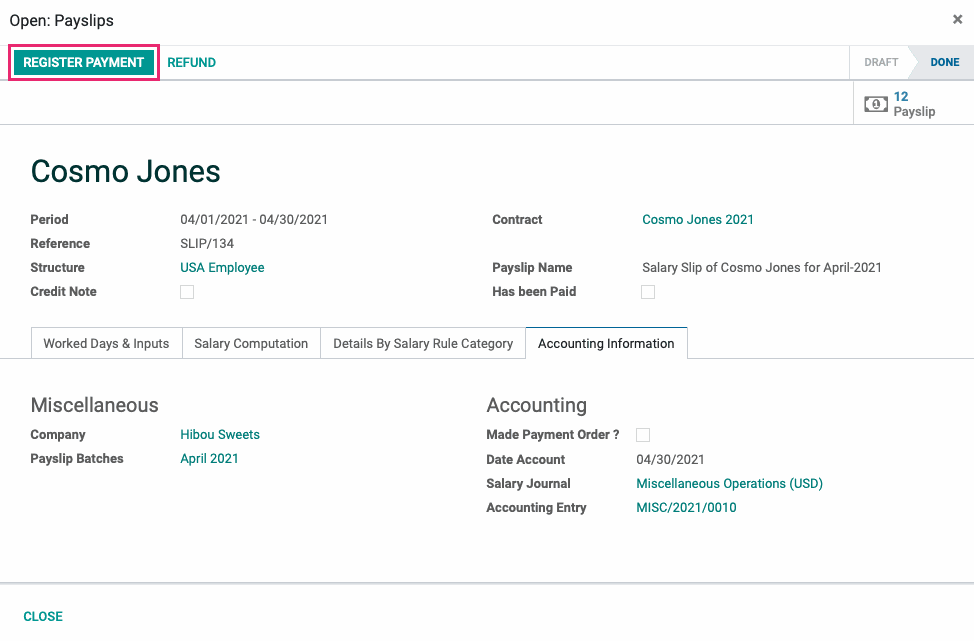
Here you should verify the details of this payment before proceeding:
Partner: The contact record that represents the employee's private mailing address. This field is populated from the employee template.
Payment Method: The account this employee is being paid from. If you don't see these options, try re-selecting the Payment Method to force the options through.
Payment Type: The manner by which the employee is being paid.
Payment Amount: The amount being paid to the employee for this payslip. This field is populated from the payslip.
Payment Date: The date of the payment is being issued to the employee.
Memo: The payslip name, populated from the payslip.
Payment Transaction: You can leave this field empty as it does not apply to payroll.
When you've verified all information is correct, click VALIDATE. Note that this only records that you've made a payment by the payment type shown. This does not pay your employee on your behalf.
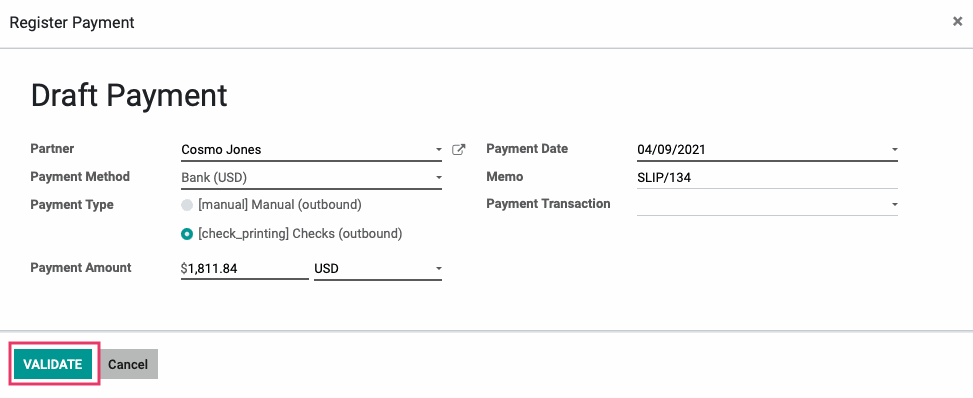
Repeat this process for all payslips. Once you have registered payment on all the payslips, you can click Close, which completes the batch.
